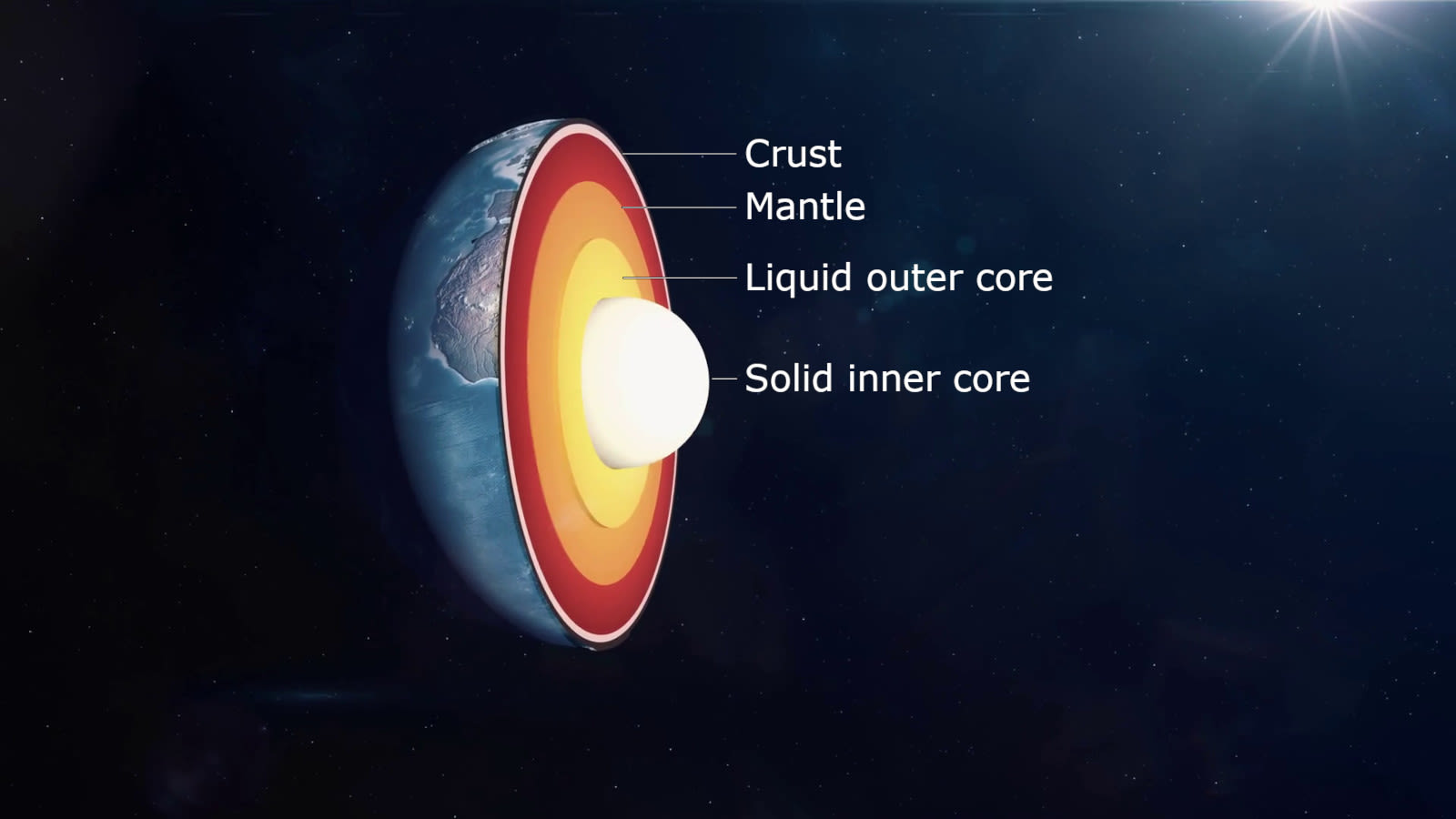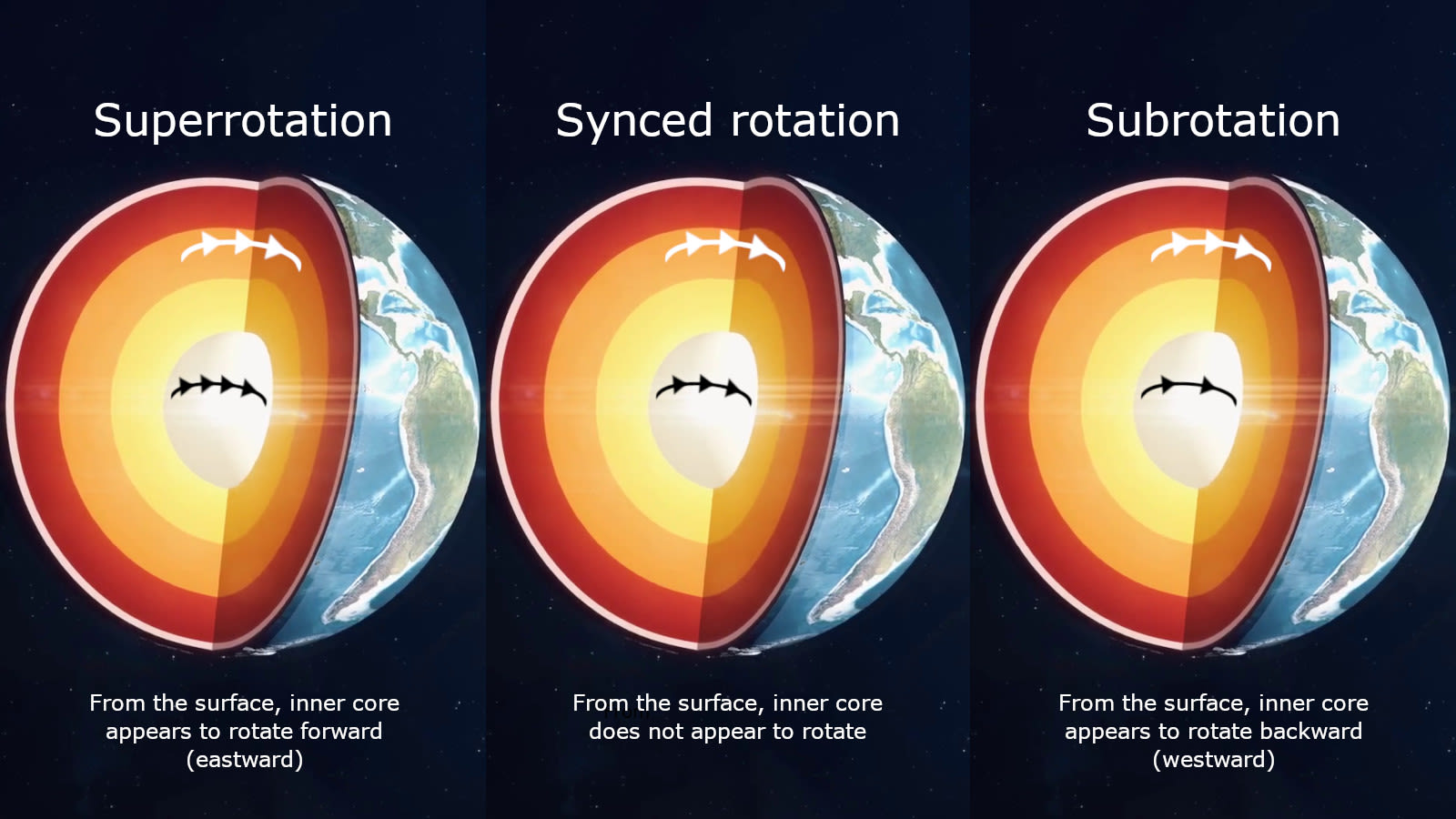Submitted by Michael Frankfort @mfrank_76
Earth’s core appears to have reversed its spin. So what does this mean?

The solid metal core of Earth doesn’t rotate perfectly in time with the rest of the planet, and new research suggests that it may have reversed direction.
At the centre of our planet is a solid mass of nickel and iron, crushed down by gravity into a sphere roughly 2,400 kilometres wide. This solid core is surrounded by an outer layer of liquid iron and nickel, which generates Earth’s protective geomagnetic field, and beyond that are the layers of the mantle and finally the crust.
 This diagram shows the different layers of Earth’s interior — the solid iron-nickel inner core, the molten liquid iron-nickel outer core, the layers of the mantle, and the crust. Credit: Storyblocks/SpaceStockFootage/Scott Sutherland
This diagram shows the different layers of Earth’s interior — the solid iron-nickel inner core, the molten liquid iron-nickel outer core, the layers of the mantle, and the crust. Credit: Storyblocks/SpaceStockFootage/Scott Sutherland
We know that the interior of Earth is arranged in this way due to decades of study by Earth scientists. They did so by examining the behaviour and timing of seismic waves travelling through the planet in the wake of earthquakes. While most seismic waves stop at the outer core, as they are absorbed by the liquid metal, waves from particularly powerful earthquakes can penetrate right through to the solid inner core and back out.
By carefully selecting specific seismic waves, scientists can focus on studying different properties of the inner core. Repeating earthquakes — those that occur in the same location at different times — are particularly useful for this. Since the seismic waves originate from the exact same location, they should travel along exact same paths and thus have the exact same shape when they’re recorded by seismographs. If there’s any difference, it’s because something inside the Earth changed.
Seismic waves from powerful repeating earthquakes do show up differently at different times. The best interpretation of this is that the rotation of the core is changing over time, relative to the rotation of the mantle. That is… the core is always rotating in the same direction that the entire planet rotates (eastward), but sometimes it rotates faster than the outer layers, other times it rotates slower, and there are times when the rotations match up.
To someone standing in one spot on Earth’s surface, these three states can appear, respectively, as though the core is spinning forwards, backwards, or that the spin has stopped.
 This cut-away diagram of Earth’s interior demonstrates the different rates of rotation of the inner core relative to the mantle and crust, and how those rotations appear to someone on the planet’s surface. Credit: Storyblocks/SpaceStockFootage/Scott Sutherland
This cut-away diagram of Earth’s interior demonstrates the different rates of rotation of the inner core relative to the mantle and crust, and how those rotations appear to someone on the planet’s surface. Credit: Storyblocks/SpaceStockFootage/Scott Sutherland
So, what’s this all about?
A new study, published this week in the journal Nature Geoscience, examines several decades worth of data, looking for patterns in the inner core’s rotation. Researchers Yi Yang and Xiaodong Song, from SinoProbe Lab at Peking University, in Beijing, China, searched through data from 1964 to 2021 to find repeating earthquakes strong enough to produce seismic waves that could penetrate through the inner core.
Their results show that the inner core stopped spinning, relative to the mantle, from around 2009 to 2020. Since 2020, it now appears to be spinning backward. A similar pause in the rotation of the core was found in the late 1960s and early 1970s.
 This graph from the research paper shows the change in the rate of core rotation since 1964 (purple and blue), along with an inverted plot of the changes in the length of a day on Earth over that same time period (gray). Credit: 2023, Yang, Y. et al/Nature Geoscience
This graph from the research paper shows the change in the rate of core rotation since 1964 (purple and blue), along with an inverted plot of the changes in the length of a day on Earth over that same time period (gray). Credit: 2023, Yang, Y. et al/Nature Geoscience
As shown in the graph above, the changes in the rate of rotation of the inner core appear to match up with the pattern of variations in the length of day (LOD) on Earth from the past 60 years or so. Note that the graph shows the LOD variations flipped upside down, thus the more superrotation of the core, the shorter the length of day, and the more subrotation, the longer the length of day. The data is shown in this way to better line up the curves.
According to Yang and Song, variations in the length of day and Earth’s geomagnetic field follow a pattern roughly six to seven decades long. With the variations in the rotation of the inner core revealed here, this means that it could also have a six to seven decade oscillation. However, they admit that since the full data record only covers a period of 56 years, they don’t have enough information yet to confirm that longer oscillation.
This isn’t the first research to show this kind of oscillation for the rotation of Earth’s core.
In 1996, a paper by Song and Paul Richards showed the first observational evidence that the core could rotate at a different rate than the rest of the planet. Although it sparked some debate at the time, they went on to independently confirm this discovery in the years ahead.
A study published last June examined seismic data from nuclear bomb tests to closely track how the inner core rotation changed from 1969 to 1974. Their results show that the core was subrotating from 1969-1971, and superrotating from 1971-1974, the exact transition revealed in the graph above. However, the researchers note a roughly six-year cycle to the oscillation, rather than 60-year.
